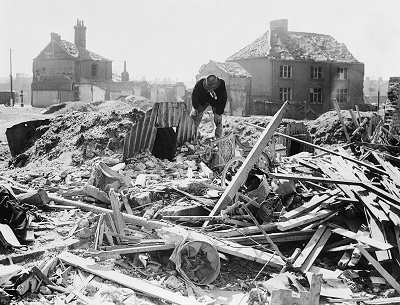A SIMPLE but very effective piece of engineering which saved many thousands of lives during the Second World War began to be distributed to householders 80 years ago today.
The Anderson shelter was a rudimentary bomb shelter which people could bury in their gardens and take refuge in during Nazi air raids. Despite appearing quite flimsy when delivered in kit form, it proved remarkably effective when assembled according to the official Government instructions.
 More than 3.6 million Anderson shelters were erected before and during the war, and some can still be found today. The shelter was designed in 1938 by William Paterson and Oscar Kerrison, who were tasked by the Home Office with devising a strong shelter for up to six people which could be cheaply mass-manufactured and assembled by unskilled householders using minimal tools.
More than 3.6 million Anderson shelters were erected before and during the war, and some can still be found today. The shelter was designed in 1938 by William Paterson and Oscar Kerrison, who were tasked by the Home Office with devising a strong shelter for up to six people which could be cheaply mass-manufactured and assembled by unskilled householders using minimal tools.
The design they came up with was named after Sir John Anderson, the high-ranking civil servant given special responsibility for preparing air raid precautions in the months leading up to the outbreak of war. As such, it was he who initiated the development and evaluation of the shelter before releasing the design for production by various manufacturers.
The shelter was essentially a small corrugated steel shed with a curved roof which was designed to be partially buried then covered over with soil or sandbags. Starting on February 25th, 1939, one-and-a-half million Anderson shelters were delivered to homes in North London, seen as the most likely target for bombing raids by the German Luftwaffe due to its high concentration of industry. They were issued free of charge to householders who earned less the £5 per week (about £300 in today’s money) while those on higher incomes were charged £7 (about £430 today) for their shelter.
The shelters came in kit form with an instruction booklet for assembly which you can see by clicking here. Six curved sheets of galvanised corrugated steel were bolted together at the top to form the main body of the shelter, which sat in steel channel sections. More straight panels were bolted on each end, one containing the door, giving 14 panels in total. All the bolts and other fixings were supplied along with a spanner to tighten them up. Once assembled, the shelter stood six feet high, four-and-a-half feet wide and six-and-a-half feet long.
Its strength came from its curved roof (able to withstand considerable force from above), its construction material which could flex to absorb and spread impact, and from the next stage of the installation process – burying it in the garden. The assembled shelter was to be sited in a hole dug at last four feet deep, with the excavated soil then banked up and piled over the top to a depth of at least 15 inches. In some cases, sandbags could be used instead of soil and only the entry door was left open to the air, sometimes with steps or a ramp leading down to it.
In some cases, Anderson shelters could be assembled inside people’s homes and covered with sandbags, but most were sited outdoors, away from the house. The earth banks built up around and over the shelter could be planted with flowers or vegetables and some neighbourhoods even held informal competitions for the best-planted or most attractive shelters.
Whenever the air raid sirens sounded, or on nights when bombing raids were anticipated, whole families would move into their Anderson shelter and pray the Nazi bombs missed them. It was up to individual households to furnish their shelters so they varied greatly in levels of comfort. Many people built rudimentary bunkbeds inside their shelter and some equipped them with radios for both entertainment and information.
However, in winter, they could become cold, damp holes in the ground, prone to condensation collecting on the corrugated steel from what little warmth was inside. Although a basic drainage sump could be installed, many were prone to flooding when it rained. They were not very pleasant places to spend a cold winter’s night and some families eventually stopped using them, preferring to take the risk of staying warm and dry inside their homes. For some, it was a fatal mistake.
Despite their basic construction, Anderson shelters withstood blast and ground shock remarkably well, able to absorb a great deal of energy without collapsing. Although houses looked more solid, they were not designed to withstand bomb blasts. After some of the heaviest bombing raids during the Blitz, families would emerge shaken but unscathed from their Anderson shelters to find whole streets reduced to rubble all around them. They undoubtedly saved tens and perhaps hundreds of thousands of lives.
Because they were unappealing places to spend a night, Anderson shelters were eventually replaced with ‘Morrison shelters’, designed to be assembled indoors. Again supplied in kit form and free to poorer households, these were a kind of steel cage which people could scurry into during raids or sleep in at night. They resembled a large table with heavy steel legs, a steel plate top and welded wire mesh sides. Around 600,000 were distributed and these too saved countless lives.
Many Anderson shelters survived long after the war and some can still be found today in their original settings, while others have been preserved or reconstructed in museums. Some were dug up and repurposed as garden sheds or even small garages for motorcycles. Our picture shows two Anderson shelters still intact amid the rubble of bombed houses in Norwich.
